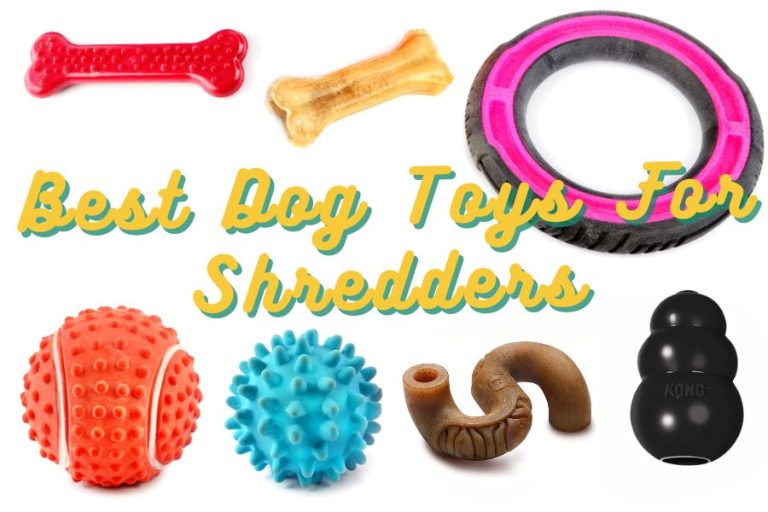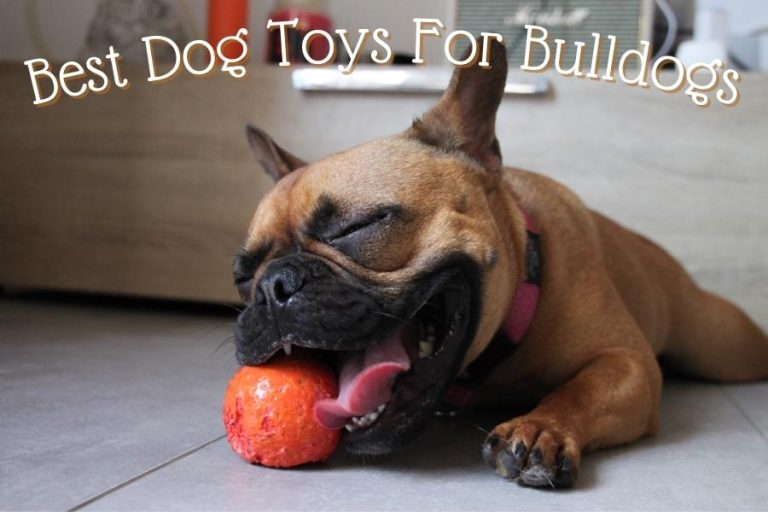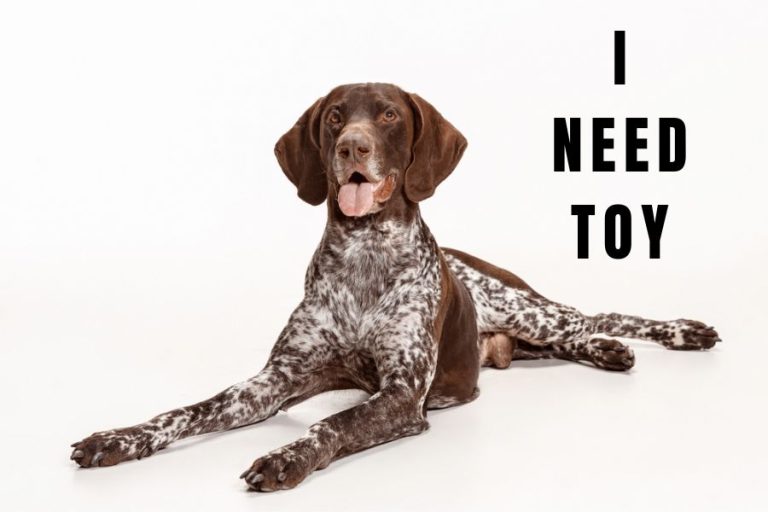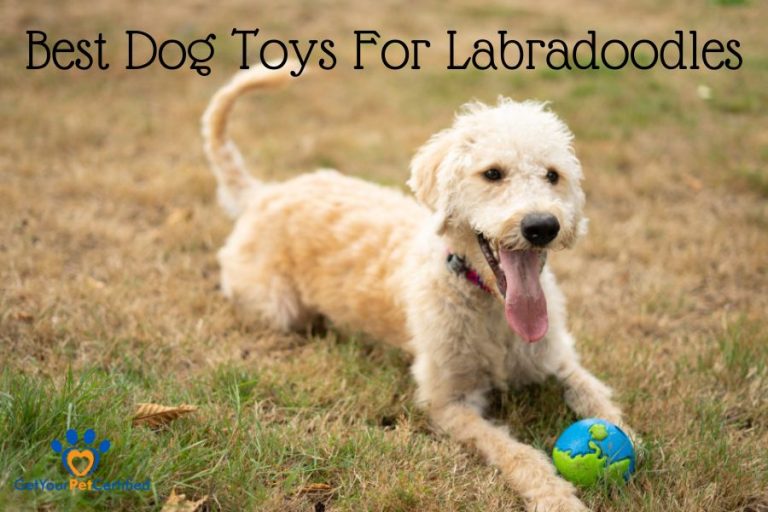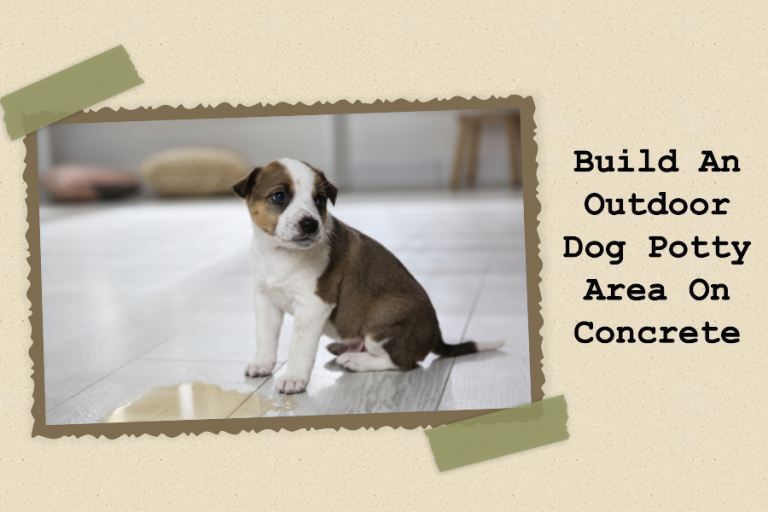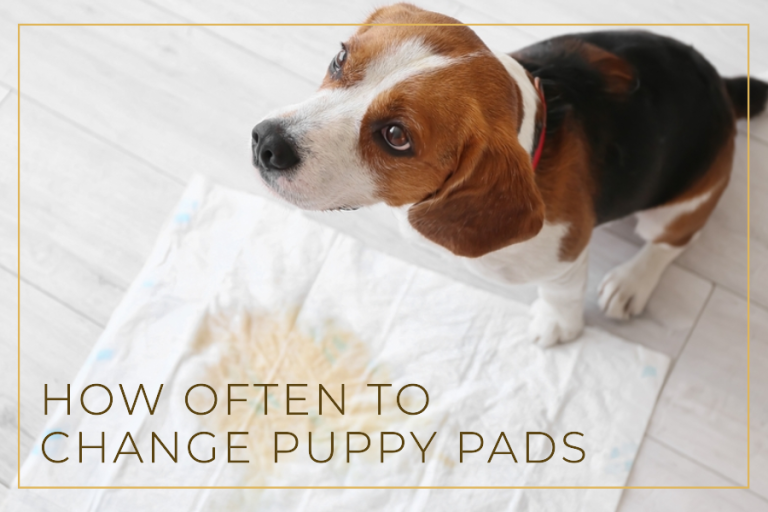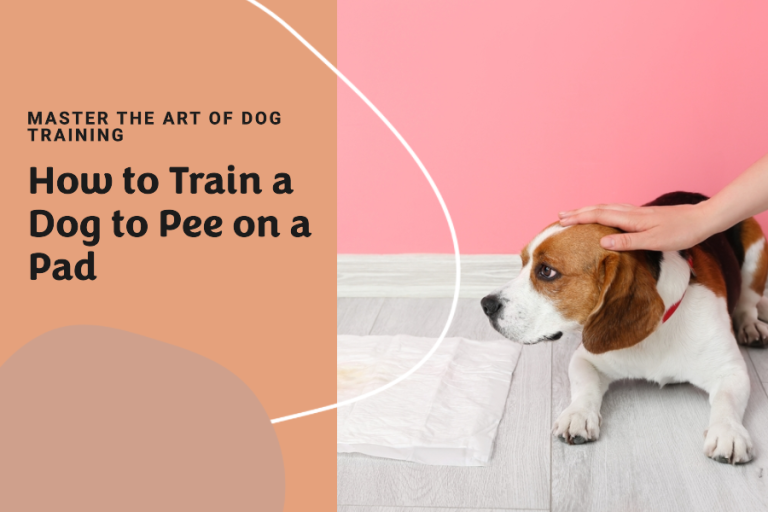Should I Put a Puppy Pad in the Crate? – Smart Solution or Training Setback?
Introduction
Welcoming a new puppy into your home is like adding a burst of joy and a bundle of challenges rolled into one. Imagine this: it’s 3 AM, and your adorable pup whines in their crate. You’re faced with a choice – to pad or not to pad? Should I Put a Puppy Pad in the Crate? This question can leave even the most experienced dog owners scratching their heads. Leading to a whole lot of confusion and some very wet mornings.
Well, we’re here to clarify. You’ll gain a clear understanding of the benefits and potential drawbacks of using pads in a crate, ensuring your furry friend’s comfort and health are prioritized. This article aims to provide a holistic perspective, from the advice of experts to actionable suggestions for training your puppy. So stick with us as we explore the ins and outs of puppy pad use and crate training.
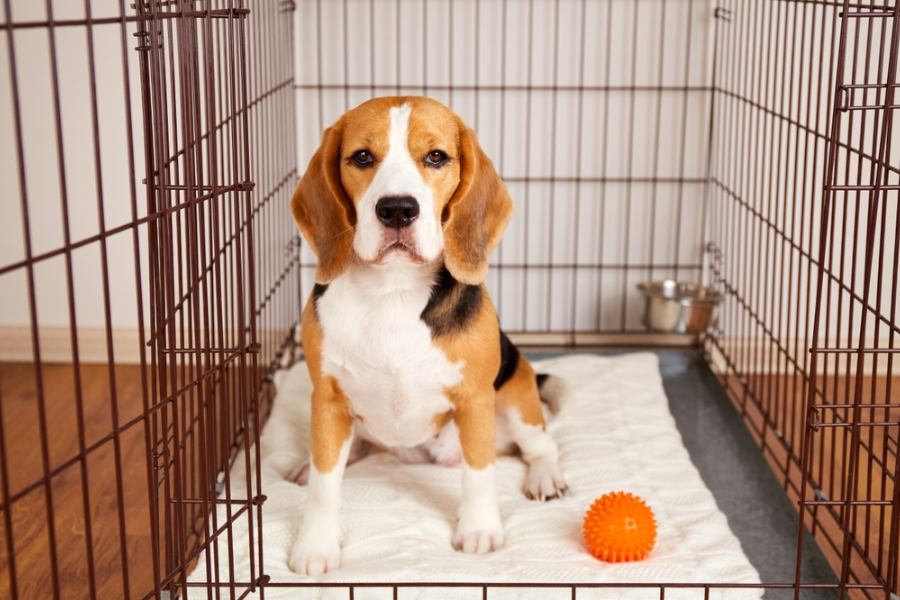
Should I Put a Puppy Pad in The Crate?
Using a puppy pad in a crate can be both beneficial and problematic, depending on various factors such as the age of the puppy, crate training goals, and the puppy’s individual habits.
As we researched from experts and other experienced pet owners, we would advise that the decision to place a puppy pad in your puppy’s crate depends on several factors. It helps manage accidents and maintains cleanliness. For very young puppies who have not yet developed full bladder control, a puppy pad can be a practical solution, especially during overnight hours or if you’re away for extended periods.
However, it’s crucial to consider the impact on house training. As your puppy grows and gains better bladder control, gradually phasing out the puppy pad from the crate will align with its natural instinct to keep its resting area clean.
Benefits of Putting a Puppy Pad in the Crate
Using puppy pads in crates has several advantages, especially during the early stages of puppyhood and house training.
- Good for Unvaccinated Puppies
- Convenience for Owners
- Useful in Apartments
- Reduces Crate Cleaning
Firstly, using a puppy pad in the crate aids in housebreaking. By absorbing accidents, puppy pads can reduce the frequency of cleaning required for the crate, keeping the environment more hygienic. The pad serves as a designated spot for your puppy to eliminate, helping to establish a routine and making the housebreaking process smoother.
Additionally, puppy pads can be a practical solution for those living in apartments. This reduces stress for the puppy, as they instinctively do not like to soil their sleeping area. Hence, a clean crate equates to a happier puppy.
Drawbacks of Putting a Puppy Pad in the Crate
Using a puppy pad in the crate, while helpful in certain situations, also comes with several drawbacks that are important to consider:
- Cost Over Time
- Dependency Issues
- Hygiene Concerns
- Chewing and Tearing Risks
However, there are also drawbacks to consider. One potential issue is that it could encourage your puppy to pee in the crate. Puppies might become too dependent on the pads and struggle to adapt to being eliminated outside. Additionally, puppies are known to be playful and curious, and they can tear up the puppy pad, resulting in a messy crate.
If not changed regularly, soiled pads can lead to an unhygienic environment in the crate. The ongoing expense of purchasing puppy pads can add up, especially if used frequently and over a long period of time.
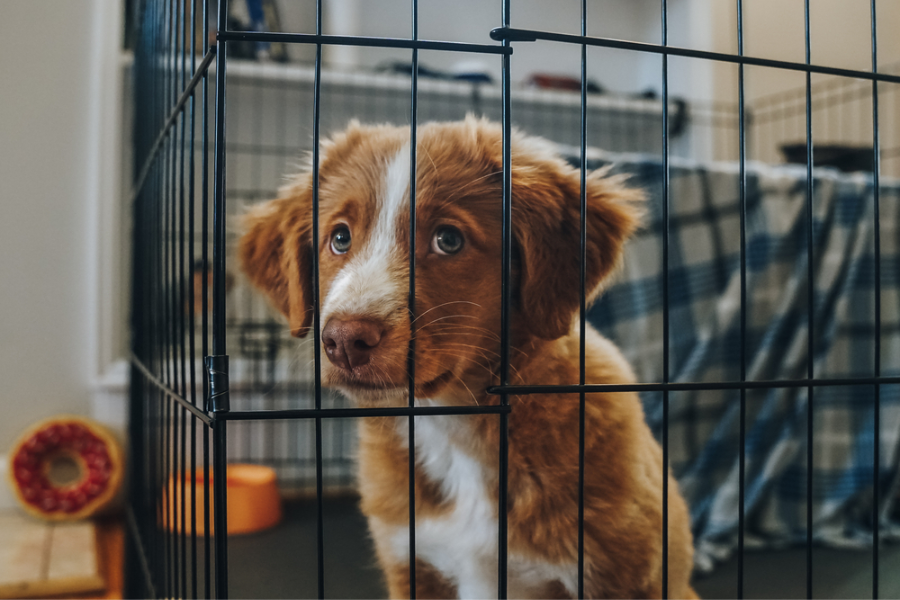
Expert Opinion on Placing Puppy Pads in Crates
There’s a split in expert opinion on this matter. Some dog trainers recommend using puppy pads in the crate, particularly in the early stages of housebreaking.
They argue that it provides a consistent, safe space for the puppy to eliminate, which is crucial in establishing a routine.
On the other hand, some experts suggest that using puppy pads in the crate could delay housebreaking as it might confuse the puppy about where it’s acceptable to eliminate.
What Not to Put in a Puppy Crate?
While we’re on the topic of what to put in a puppy crate, it’s also crucial to know what not to include. Items that can be harmful or dangerous for your puppy should never be left in the crate.
These include chewable toys that can turn into choking hazards, food bowls that could lead to overeating, and any loose bedding that could be ingested or cause overheating. These items can pose serious risks to your puppy’s health and safety, including choking, injury, and ingestion of harmful substances.
In summary, deciding whether to put a puppy pad in the crate depends on your specific circumstances and your puppy’s needs. It’s essential to weigh the benefits and drawbacks and consider expert opinions before making your decision.
Puppy’s Development And Your House Training Goal
For extremely young pups, particularly those under 12 weeks old, a puppy pad in the crate might be required since they have minimal urine control.
The use of puppy pads should be progressively reduced as your puppy matures and gains control of his bladder, generally between the ages of 3 and 6 months. Consistent house training should occur at the same time as the move.
Once your puppy starts to show control and an understanding of where it’s appropriate to eliminate (ideally outside), begin phasing out the use of the puppy pad. This could be around the age of 6 months, but it varies with each dog.
Should You Put Puppy Pads in Crate At Night?
As pet lovers, we get asked a lot, “Should you put puppy pads in the crate at night?” The answer depends on your pup. Let’s dig in and figure this out together.
What Goes in the Crate at Night?
Let’s make your pup’s crate comfy. A soft bed, a favorite toy, and maybe some water (if your vet says it’s okay) can make the crate feel like home. These things help your puppy feel safe and sleep better.
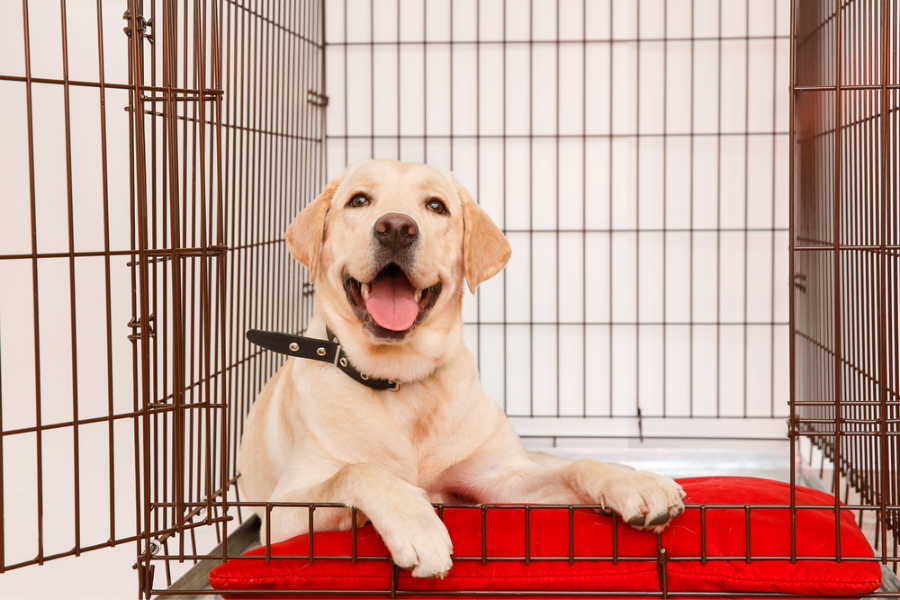
Puppy Pads in the Crate: Yes or No?
Puppy pads can be a big help at night. They catch messes if your puppy can’t hold it all night, which keeps the crate clean. But there’s a catch. If you use them too much, your pup might think it’s okay to pee in the crate. This could slow down house training.
But if you’re still working on potty training, puppy pads can help. They give your pup a spot to go potty, which can mean fewer accidents.
How These Items Keep Your Pup Comfy and Safe
All these things in your pup’s crate can help your pup feel comfortable and safe. The bed gives your pup a cozy spot to snooze. The toy helps your pup feel at home. If your vet says it’s okay, water can keep your pup from getting thirsty. And the puppy pad keeps things clean.
Alternatives To Puppy Pads In Crates
If you’re considering alternatives to using puppy pads in crates, there are several options you can explore:
- Washable, Reusable Pads: These are eco-friendly and cost-effective over time. Made from fabric, they are absorbent and can be washed and reused. They are also generally more durable than disposable pads.
- Artificial Grass Pads: These simulate grass and can be helpful for transitioning a puppy to outdoor potty habits. They often come with a tray underneath to catch liquid. They’re more expensive, but can be cleaned and reused.
- Newspaper: Before the widespread use of puppy pads, newspapers were commonly used. They are absorbent and readily available. However, they can be messy and less absorbent compared to puppy pads.
- Pee Post or Potty Attractants: These are products designed to encourage dogs to urinate in a specific area. They can be used in combination with other methods, like artificial grass pads, to train the puppy where to go.
Where is The Best Place to Put a Puppy Pad?
Choosing the perfect spot for your puppy pad can be a puzzle. To effectively housebreak your pup, you need to consider a few essential factors. The location of the puppy pad can play a pivotal role in your puppy’s training progress.
Factors to Consider When Choosing the Location for a Puppy Pad
Firstly, the proximity to your puppy’s sleeping area is crucial. We recommend placing the pad not too far from the crate but also not directly inside. This way, your puppy doesn’t associate their sleeping area with their bathroom area, which can hinder their housebreaking progress.
Secondly, consider the foot traffic in your home. It’s best to place the puppy pad in an area that’s easily accessible but not in a high-traffic spot. Too much activity can distract your puppy and make them feel anxious about using the pad. Avoid places that require climbing or navigating obstacles, especially for very young puppies.
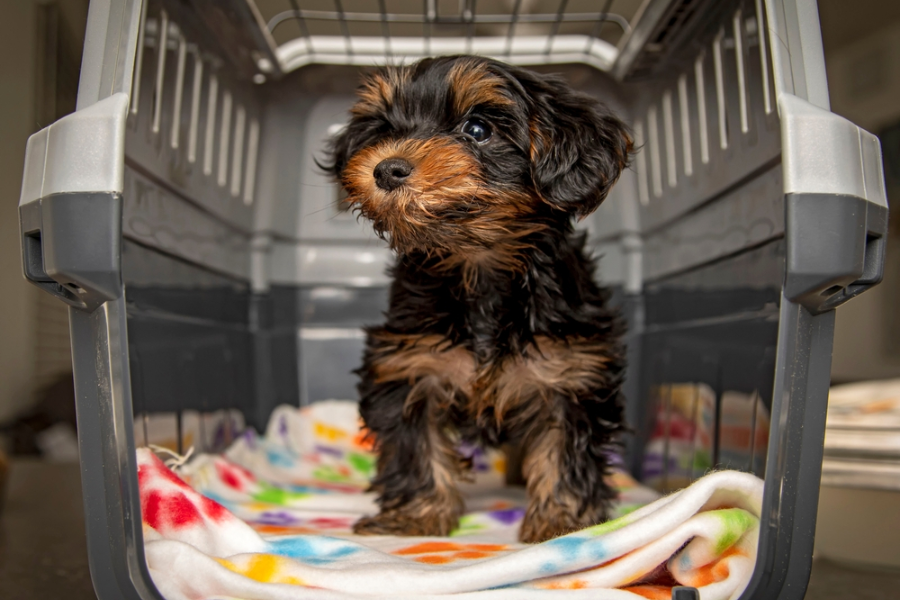
Different Suitable Places for a Puppy Pad
Now that we’ve discussed the factors to consider, let’s delve into potential locations for the puppy pad. We should stay away from feeding and sleeping areas
Near exit, laundry room, or a bathroom are all suitable places. These areas usually have hard floors, making them easy to clean in case of any ‘misses’ or if the puppy pad leaks.
- Near exit is often a hub of activity, but it can also offer a quiet corner for your puppy’s pad.
- The laundry room can be an excellent choice as it’s typically low-traffic, yet easily accessible.
- A bathroom can also work, provided it’s not too far from the puppy’s crate and not used frequently by the household members.
Remember, consistency is key in puppy training. Once you’ve chosen a spot for the puppy pad, try to keep it there. Regularly moving the pad around can confuse your puppy and slow down their training progress.
How Do You Train a Puppy to Pee in a Pad Crate?
Training a puppy to pee in a pad crate is a process that requires patience, consistency, and positive reinforcement. Here is our step-by-step guide to puppy pad training:
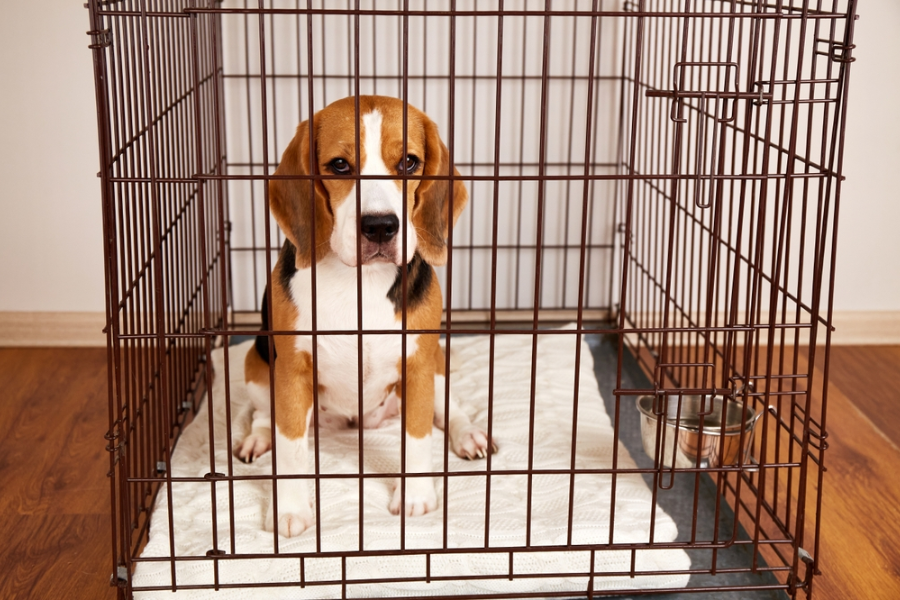
Step-by-step Guide to Puppy Pad Training
Lesson 1: Introducing the Puppy Pad
- Creating a Positive Association: Begin by placing the puppy pad in a designated spot.
- Allow the puppy to explore and become familiar with the pad on their own.
- Encouraging them gently and maintaining a positive tone helps them associate the pad with a good experience.
Lesson 2: Recognizing the Need to Go
- Observation Skills: Learning to recognize when a puppy needs to eliminate is crucial. Typical signs include sniffing, circling, and sometimes whining.
- At the first sign of these behaviors, it’s important to guide the puppy to the pad. This step requires consistency and patience.
Lesson 3: Positive Reinforcement
- Rewarding Success: Immediately after the puppy uses the pad, reward them with praise, petting, or a small treat.
- This reinforcement makes the puppy more likely to repeat the behavior. The key is to be immediate and enthusiastic with the reward.
Lesson 4: Establishing a Routine
- Consistent Scheduling: Regularly taking the puppy to the pad, especially after meals, playtime, and naps, helps establish a routine.
- Setting a timer can be a helpful reminder to maintain this consistency.
Lesson 5: Handling Accidents
- Patience and Persistence: Accidents are a normal part of the training process. Instead of scolding, calmly clean up and continue with the training.
- Patience during this phase is crucial for maintaining progress.
Lesson 6: Transition to Outdoors
- Moving Beyond the Pad: As training progresses, gradually start moving the pad closer to the door and then outside, if outdoor elimination is the goal. This helps the puppy associate going outside with elimination.
Tips for Successful Pad Training
Maintaining a consistent schedule is crucial for successful pad training. Feed your puppy at the same times each day and take them to the pad regularly, especially after meals, playtime, and sleep. This will help your puppy learn when and where to eliminate.
Using positive reinforcement is also important. Always reward your puppy immediately after they use the pad. This will make the behavior more likely to be repeated. Avoid punishing your puppy for mistakes, as this can cause fear and confusion.
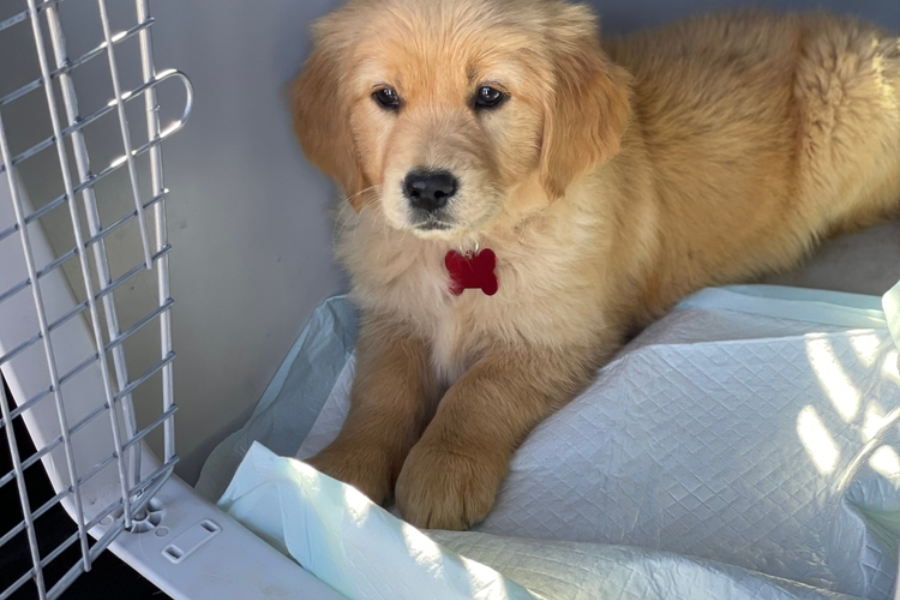
How to Handle Common Challenges in Pad Training
One common challenge in pad training is the puppy ignoring the pad. If this happens, try moving the pad closer to where your puppy spends most of their time. You can also try using a pad with a scent-attractant.
Another challenge is the puppy tearing up the pad. To prevent this, you can try using a pad holder or a pad with adhesive strips to keep it in place. You can also provide chew toys to distract your puppy from the pad.
Remember, patience and consistency are key in pad training. It may take some time, but with positive reinforcement and a regular schedule, your puppy will eventually learn to use the pad in the crate.
Conclusion
We’ve learned a lot about puppy pads in crates. They can help with house training and keep the crate clean. But, they might also cause some trouble. For example, your puppy might start thinking it’s okay to pee in the crate. Or, they might tear up the pad and make a mess.
We also talked about using puppy pads at night. They can help if your puppy can’t hold it until morning. But, they might also teach your puppy to pee in the crate at night. We also shared tips on where to put the pad and how to train your puppy to use it.
In the end, it’s up to you. You know your puppy best. If you think a puppy pad in the crate will help, give it a try. If not, that’s okay too. Just remember, training your puppy takes time and patience. But, it’s all worth it in the end when you have a happy, well-behaved pup.


